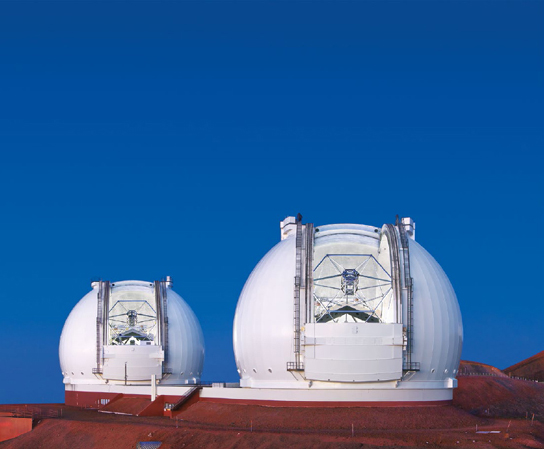1993
Giant Telescopes
The frontier of modern astronomy has been defined during the last few centuries by the limits of telescope and instrument technology. The need to observe extremely faint sources (oftentimes adjacent to much brighter sources) at extremely fine resolutions, to acquire spectroscopic observations over a wide range of the electromagnetic spectrum, and to accurately record observations for later detailed analysis have all pushed astronomy, and astronomers, to the cutting edge of optics, engineering, electronics, and software design. Perhaps nowhere is this more visible than in the recent proliferation of truly enormous optical telescopes at premier observing sites around the world.
When the 200-inch (5-meter) telescope mirror was cast for the Hale telescope at Mount Palomar in the late 1940s, it was a miracle of then-modern engineering. In the decades since, materials and mechanical engineering methods have improved dramatically, but still the largest practical single-mirror telescope size has only grown to about 320 inches (8 meters) because of gravity and materials’ strength limitations. To substantially increase the light-collecting area has required engineers and opticians to innovate, and a key innovation has been the development of segmented mirrors—smaller, more practical mirrors that, when assembled together, simulate a single mirror of much larger size.
The first large-scale experiment in segmented-mirror telescopes was the twin 400-inch (10-meter) telescopes of the W. M. Keck Observatory atop Mauna Kea, Hawaii. Each telescope’s mirror consists of 36 hexagonal, 70-inch (1.8-meter) segments that are individually and dynamically computer controlled to form a near-perfect giant parabolic reflector. Keck I went online in 1993; Keck II in 1996. Both have enabled incredible scientific discoveries ever since.
Two Keck telescopes were built to try to exploit another innovation in giant telescope design—using two or more telescopes, it is possible through electronics and software to combine the data from each telescope to yield angular resolutions equivalent to a single enormous telescope as large as the separation between the individuals. This process is known as interferometry. The Keck telescopes are just one example of a growing number of large optical interferometer telescopes that are now defining the newest frontier in ground-based astronomy.
SEE ALSO First Astronomical Telescopes (1608), Arecibo Radio Telescope (1963), Hubble Space Telescope (1990).
The twin telescopes at the Keck Observatory, near the summit of the extinct Mauna Kea volcano (elevation 13,600 feet [4,145 meters]) in Hawaii. Each telescope is 10 meters (33 feet) in diameter.
